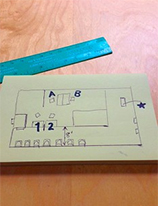Privacy? Not in My Doctor's Office
| September 5, 2013

A few months ago, I complained about the layout of one of my doctor’s offices. There’s a rough layout drawing of the office waiting area to the side there. I’m standing just in front of the number 1, while people are sitting along the wall behind me.
Do you see the problem?
After I identify myself with both my date of birth (Seriously, this is the first thing the “medical secretary” asks you for when you walk in — already setting the tone for the visit — you’re just a number to them) and then my name, I have to discuss the reason for my visit. Just about 6 feet away from all the other patients sitting in what passes for a “waiting room” (really just a hallway with some uncomfortable chairs in it).
I’m not concerned about HIPAA (Health Insurance Portability and Accountability Act). I’m concerned about how little my doctor cares for my privacy in their own office.
I walk in and stand waiting in front of the two “medical secretaries'” desks (labeled 1 and 2 in the drawing). Both are on the phone when I come in, because apparently both are on phone duty as well as addressing the actual people standing in front of them. Awkwardly. Waiting. With a sample.
Another person comes up and stands next to me, oblivious to the fact that I’m also waiting for the first available secretary.
The first secretary finishes with her phone call, ignores me, and starts talking to the person who stood next to me. Zero awareness of who was there first, and a look that says, “Don’t bother me with your petty problems, menial patient!”
After about 5 minutes of standing there, waiting, the second secretary finally finishes up with her phone call.
“Date of birth?”
No, “Hello, how are you?” No, “Hi! What’s your name please?”
Nope, my first interaction is simply regurgitating my number. How utterly dehumanizing. I sputter out my date of birth, heard easily by a half dozen patients in the waiting area.
“Your name?”
I say my name, realizing that if someone is into identity theft, they are pretty much halfway there with me just wanting to check in with the doctor’s front desk.
Type, type, type…She types furiously at her computer terminal, never cracking a smile, never saying a word of welcome or encouragement. The amount of typing she’s doing just to pull up my medical record is worrying.
I look beyond these medical secretaries and notice that other office personnel (A and B in my drawing) — oblivious to the growing line behind me — are easily also within earshot of my discussion with the front-desk folks. One woman looks at me as she’s having a great conversation with a co-worker, laughing.
Are they talking about me? I hope not, but given my lack of privacy here, I have no idea. I try and put my ridiculous paranoid thoughts aside.
“What brings you in today?”
“I’m here to drop off this sample for Dr. Smith,” I say.
Back to the computer screen. Type, type, type. Ignore the patient again for a minute or two, while all this data needs to be entered. A few minutes later, she actually looks up at me as she hands me a printer-generated label for my sample.
“Place this on the sample, and then put the sample in the tray.”
“Umm, where’s the tray?”
“The tray is around the corner. It’s labeled 'urine samples,' but put it there anyway.”
The tray is the starred item in my haphazardly drawn office layout. Walk by the other patients nonchalantly…
“Don’t mind me, just dropping off my sample…!” I think.
Around the corner I arrive and see a tray with two urine samples in it. Ewww. Okay, place my sample on the tray next to them.
Walk back up to the medical secretary’s desk, but she’s no longer there. Gone.
Just like me, never to return to this particular medical practice. Because if this is the way patients’ privacy is treated — non-existent — then I think I’ll take my business elsewhere.
The lesson in all this? If you’re a doctor, your actual office environment matters. Designing a waiting area with no regard for your patients’ privacy sends a clear and unfortunate message — their health concerns are public knowledge within your office environment, and not subject to any sense of privacy or basic human modesty.
This post originally appeared on the Society for Participatory Medicine's e-patients.net blog.










